Is Filtered Water Okay For Goldfish Overnight
A big function of fishkeeping is adding water to your aquarium.
Whether information technology'due south filling a new tank or performing a water alter, you lot need a reliable and safe source of aquarium water – the lives of your fish depend on it!
Today, I share with yous all the different sources of water you can add to your fish tank, every bit well as the pros and cons of each.
By the time you lot finish reading, you lot will know exactly which water source is best for your tank and the blazon of water.
At present, in that location are iii others you should examination. However, the ideal levels of these vary co-ordinate to what yous keep in your tank.
The importance of testing your h2o source
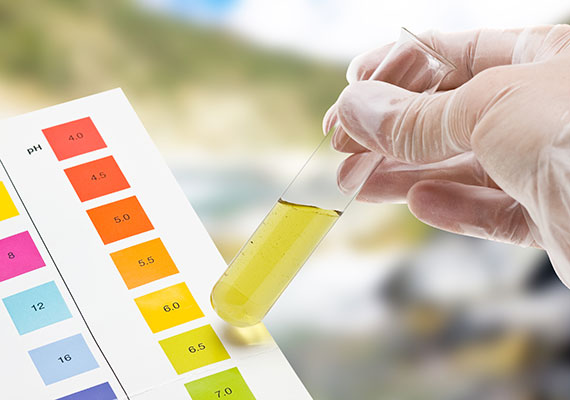
Before continuing, I want to brand i matter clear:
Whatever water you lot determine to fill your aquarium with, test it outset!
Y'all run across, water quality is the number i deciding factor in whether your fish live or die.
While you cannot see information technology, your h2o actually contains many unlike salts and elements dissolved in information technology.
Some of these are good. Others are dangerous and tin kill your fish.
Fish can conform to less-than-platonic h2o conditions. However, it does negatively impact their health and happiness. For instance, your fish may not live equally long or refuse to brood.
Part of your job as a fish keeper is to monitor these levels in your water and make adjustments as necessary.
Unfortunately, you lot won't know what's in your water until you exam it.
Don't worry! Testing is quick and inexpensive. You can practise it yourself with an aquarium exam kit. I recommend grabbing an API Main test kit. It contains almost everything you need to perform these tests.
What should you lot test for? Well, start with these four…
- Ammonia – Platonic level: 0
- Nitrite – Ideal level: 0
- Nitrate – ten ppm or less
- Phosphate – 0.05 ppm or less
At present, at that place are three others you should test. However, the ideal levels of these vary according to what you go on in your tank.
- pH
- KH
- GH
Don't stress if you exam your h2o and find that the levels are not ideal. Many products are available to improve the water quality. For example, you can employ Purigen to remove ammonia or an alkalinity buffer to increase KH.
All water sources require some preparation on your part to make it safe for your fish.
The results of your tests will guide you lot on how to make your water safe or whether you should choose a different water source altogether!
With that out of the way, allow'south look at the different sources of water you can utilize in your aquarium.
FishLab Tip: Want to do less water preparation? You may exist able to choose a species of fish that will happily alive in the parameters of your h2o source.
1. Tap water
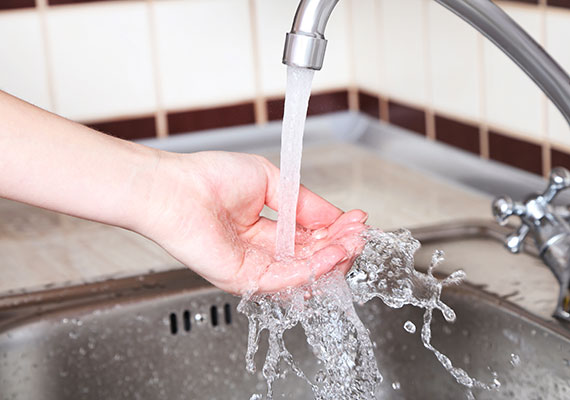
Tap h2o is the most common source for h2o in freshwater aquariums, and information technology's like shooting fish in a barrel to run across why…
Simply turn on your faucet, and you accept as much water equally you need – it's cheap and readily available.
Later all, y'all are already paying the water bill. Why make life harder by using a dissimilar water source if you don't accept to?
The good news is, for the majority of you, tap h2o is all you demand to fill your aquarium.
Just one trouble. Tap water quality varies co-ordinate to where yous live. We all know what happened with the Flint water crunch![1]
Concerned about the quality of tap water?
Inquire your local fish store!
Any fish store in your area will have used local tap water for years. If anyone has advice for using tap water to fill up an aquarium, it'south these guys.
Okay, so your tap water is safe to use?
And so, there is just one more than affair you need to do earlier adding it to your tank…
Dechlorinate your water!
Your local water supply adds chlorine or chloramine to the water to go far safe to drink. These disinfectants kill bacteria and other microbes increasing the quality of h2o.[two]
Chlorine, however, doesn't differentiate between good bacteria and bad bacteria. It destroys it all.
For your aquarium, this is a problem…
You see, bacteria live inside your aquarium filter. Skillful leaner. In fact, the entire reason you cycle your aquarium is to introduce these good bacteria.
If these benign bacteria dice, then the water volition soon turn toxic to your fish.
So, before yous add tap h2o to your aquarium, y'all must showtime dechlorinate it to proceed your fish healthy.
Fortunately, this is as simple every bit calculation a water conditioner to your aquarium. I personally recommend Seachem Prime.
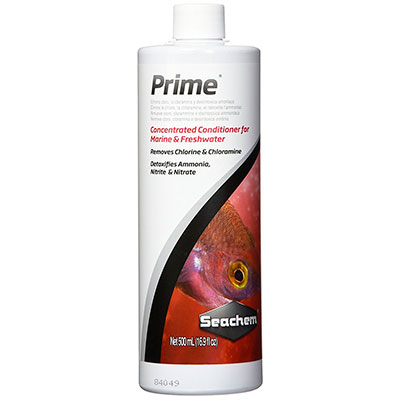
Non simply does Prime dechlorinate your tap water, simply it can also be used in an emergency to detoxify ammonia, nitrite and nitrate. If you have a freshwater aquarium, keep a canteen of this on hand at all times.
Pros:
- Readily available
Cons:
- Needs to be dechlorinated
- Variable parameters
2. Well water
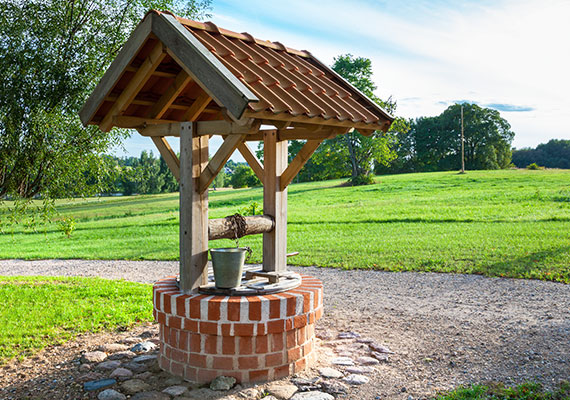
Well water is untreated groundwater that is piped into your domicile. It tin exist hitting or miss whether your well water is suitable for your aquarium.
Unlike tap water provided by your local water supply, the government does non test the quality of well water.[3]
The exact water parameters of your well water entirely depend on where you live in the country.
For example, states like Florida and Arizona have very hard groundwater while states like New York and Colorado have very soft water.[4]
Just the variations don't cease at that place…
Especially if you live in a rural area where there are lots of farms. When information technology rains, fertilizer can launder into the groundwater and contaminate it with phosphates and nitrates, which tin can lead to problems in your aquarium.
So while yous may have to harden or soften your well water, at least yous won't have to dechlorinate it – well water is chlorine-free.
I'd simply recommend well h2o if you programme on testing it regularly.
Pros:
- Bachelor in your own home
- Doesn't crave a dechlorinator
Cons:
- Unpredictable mineral content and pH
- Susceptible to runoff
- Needs regular testing
3. Opposite osmosis water (RO water)
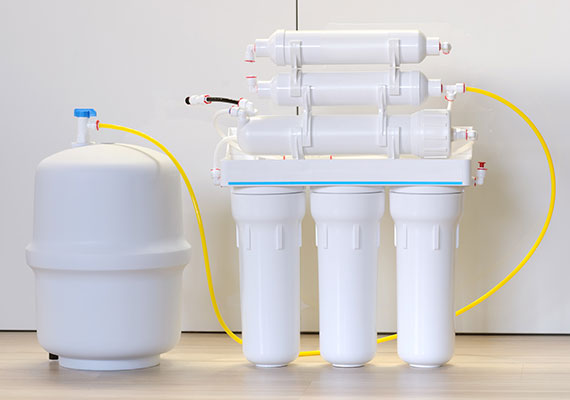
Prepare a contrary osmosis (RO) organisation nether your sink, and you'll take pure water on demand.
To put information technology simply, RO works by forcing h2o through a super fine filter called a membrane.
The holes in this membrane are so fine that only nearly pure water tin can make it through. Minerals, chlorine and even many bacteria are too large to make their way through the membrane. Reverse osmosis is capable of removing 90-99% of contaminants from water.
Purified water comes out one line while the leftover wastewater exits through another.
At present, hither's the grab…
Reverse osmosis is so effective that information technology will also filter out minerals and elements from the water. Fifty-fifty those you want to go along– the trace minerals that are essential for osmoregulation in healthy fish and a stable pH.
Fortunately, many products are available that help add the good stuff back to your RO h2o.
In a freshwater tank, use a remineralizer similar Seachem Equilibrium to restore the mineral rest.
In a saltwater tank, your salt mix adds the essential salts and elements to the water.
A reverse osmosis system ranges anywhere from $l to $300. The filters need to be replaced periodically, however. Hard water may require replacing the filter every half dozen months, while those with soft water can get up to 2 years of use before replacement.
Pros:
- Removes between 95-99% of contaminants
- Made in your ain home
Cons:
- Requires set upwards and maintenance
- Water must be remineralized
4. Deionized water (DI water)
A deionization unit of measurement is another device you tin connect to your plumbing to attain pure water for fish tanks.
Deionization works a little differently than reverse osmosis. A deionization unit contains filters filled with a chemical resin.
The science behind these chemical resins is both impressive and complex. To put it super simply, the resin attracts and traps contaminants and exchanges it for the ingredients needed to create pure water.
Deionization units remove both minerals and fifty-fifty human-made chemicals such every bit pesticides from the water.
The downside with DI systems is that they cannot remove bacteria or sediments from your water. However, when used correctly, a deionization organisation can eliminate the v-10% of contaminants that a reverse osmosis system cannot.
Just similar reverse osmosis, deionized water needs to be remineralized before being used inside your tank.
In aquariums, DI units are rarely purchased on their ain. They are used in addition to an RO system, which brings me to my side by side water source…
Pros:
- Removes contaminants that an RO organization cannot
- Purifies faster than an RO organisation
- Made in your own home
Cons:
- Cannot filter out leaner
- Requires fix up and maintenance
- H2o must exist remineralized
5. RO/DI water

What if you could go the benefits of both opposite osmosis and deionization in a single device?
Well, it turns out yous tin. An RO/DI filtration system takes advantage of both filtration methods. The result is water that is considerably more pure than using each technique individually.
The result is the purest water possible, created right in your ain home.
RO/DI units are commonly used for reef tanks, where even trace amount of contaminants can upset sensitive corals.
Pros:
- A consummate pure water solution
- Made in your own home
Cons:
- Requires set upwardly and maintenance
- Water must be remineralized
vi. Distilled water
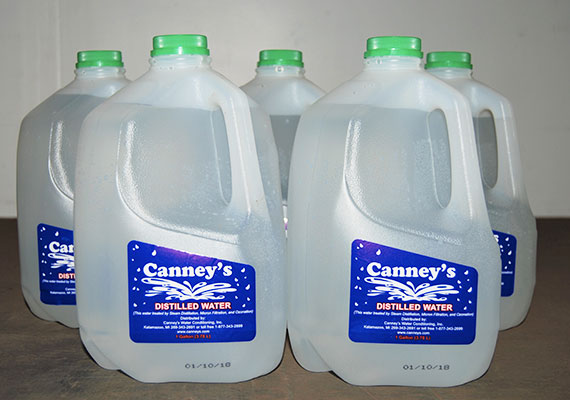
If you only occasionally need purified water, distilled h2o may be a meliorate option.
Distilled water is made in an industrial setting past boiling water to produce steam. As the h2o is boiled, it kills off bacteria. As the steam rises, it leaves behind impurities, such as chlorine and minerals.
The steam is then cooled, turning back into pure water. The water is then collected and sold as distilled h2o.
Found on the shelf of your local grocery store, you tin can choice upwards a gallon of distilled water for under a dollar.
The just downside to distilled h2o is that it's not applied for a larger tank. While distilled h2o is darn cheap, you'll demand an atrocious lot of it to fill a 50-gallon tank.
Just like with the previous pure h2o sources, you must remineralize distilled water earlier adding information technology to your tank to make sure that appropriate amounts of minerals is present.
Pros:
- Pure water
- Affordable
Cons:
- Must be purchased on an ongoing basis
- Not practical for big tanks
- Must be remineralized
7. Bottled drinking water
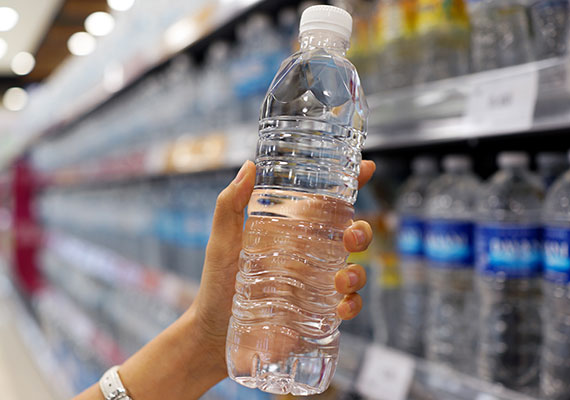
Bottled h2o is great for drinking on a hot mean solar day, only it may non be the best solution for a healthy aquarium.
You see, in that location are iii different types of bottled drinking water available:
- Purified h2o – Tap h2o that goes through an RO/DI system or distilled.
- Filtered h2o – Tap water that goes through various filters such as charcoal to meliorate taste.
- Bound water – H2o that is collected underground. Information technology may or may not go through additional filtering.
Each of these results in water with different parameters. So, you need to test your bottled water advisedly before deciding how to adjust it. For instance, some bottled h2o still needs chlorine removed.
And because bottled h2o is designed for the states to drinkable, it is oft considerably more expensive than but using distilled water.
I only recommend using bottled water as fish tank h2o in an emergency, when goose egg else is available.
Pros:
- Low in contaminants
- Sold virtually everywhere
Cons:
- Expensive
- Non practical for big tanks
- Requires testing to determine h2o quality
8. Rainwater
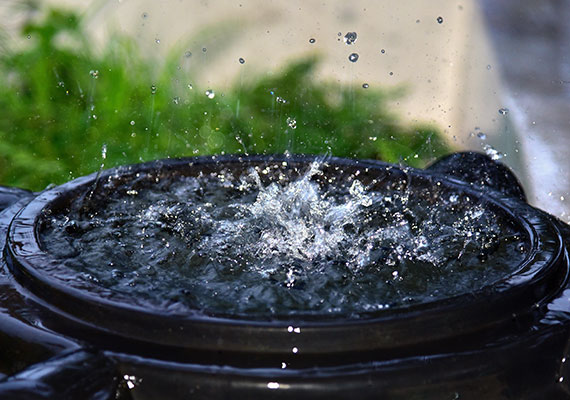
Some other form of water source for aquarium water is rain.
Rainwater has a low pH and almost no mineral content, then it requires modifying on your part earlier it is suitable for aquarium employ.[5]
All you need is a large barrel or storage tank, and y'all are set up.
Exist mindful of the few downsides to using rainwater as a water source for your aquarium.
First, you need it to rain. That makes this solution unsuitable for those living in a dry country like Nevada.
If it doesn't rain oft, then you risk running out. It is for this reason that you should always accept a fill-in water source just in case.
If the water is collected from the roof, then it may contain runoff such as asbestos, sand or grit from the shingles, not exactly aquarium-condom water. It's also easy to end upwards with leaf litter and other gunk floating in the water.
And if yous live in a large city, and so your rainwater could really exist contaminated from air pollution.
Finally, mosquitos may lay eggs in your h2o barrel. While mosquito larvae may make an fantabulous repast for your fish, your neighbors won't appreciate them when they plough into developed mosquitos.
Phew… If yous can overcome all that, then rainwater tin certainly be used as a water source for your aquarium.
Pros:
- Gratis to collect
Cons:
- Can easily go polluted
- Needs to be stored
- Dependent on the weather
- Mosquitos
9. Natural waterways
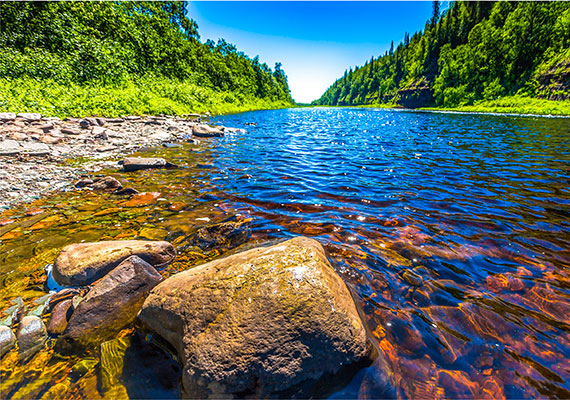
Take a stream, river or lake nearby? You may be tempted to collect water from information technology for your water alter.
I mean, you can see fish living in it, so the water must exist safe, right?
Well, not quite…
In fact, this is basically the only water source I do not recommend.
First, the fish you see in these rivers have had many, many generations to adapt to the weather condition. The fish in your tank are used to very different water.
But perhaps even more worrying, many waterways in the The states are shockingly polluted.[half dozen]
The waterway may look clean, but it may comprise toxic industrial and agronomical chemicals – none of which volition be detected by your basic aquarium test kit.
While tests that can identify this pollution are bachelor, they are prohibitively expensive.
Finally, waterways incorporate fungi, bacteria, viruses and parasites. Your pampered fish are not prepared to exercise battle with these nasties.
Every bit if that wasn't plenty to scare yous off using your local river to stock up on water…
Water is darn heavy. Do you really want to haul water back to your firm every time you perform a h2o change?
The long and the short of it:
Using h2o from rivers, streams and lakes can be dangerous to your fish.
Conclusion
If yous made it this far, then you'll have a much better thought of which water source is best for your tank.
Whichever you choose, remember:
Testing is key!
I'll say information technology again. Water quality is the single biggest gene in whether your fish live or die. And, choosing an appropriate h2o source tin make maintaining water quality much easier.
Which water do you lot utilise to make full your aquarium? Permit me know in the comments beneath!
Is Filtered Water Okay For Goldfish Overnight,
Source: https://fishlab.com/aquarium-water-sources/
Posted by: slayunty1998.blogspot.com


0 Response to "Is Filtered Water Okay For Goldfish Overnight"
Post a Comment